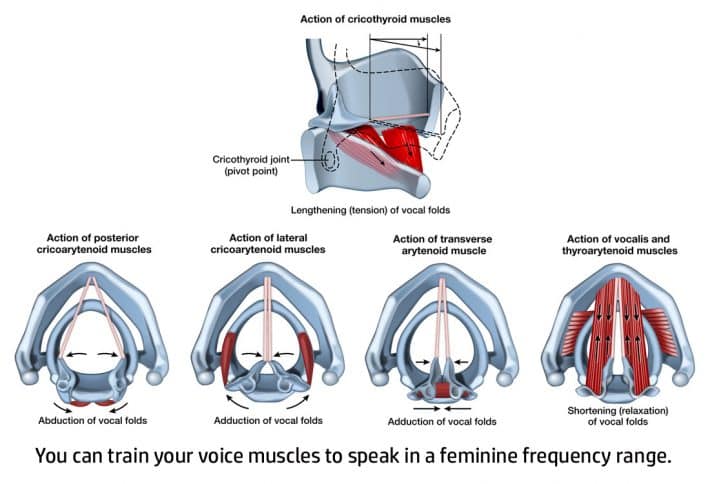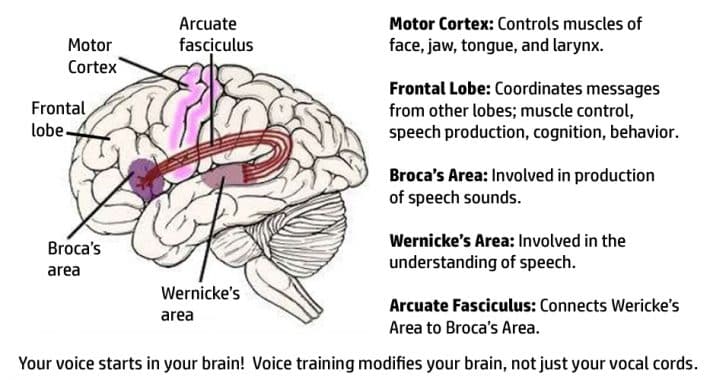
Non-Surgical Approaches to Voice Feminization
As a chiropractor, I work with living anatomy. I use intention and neurology to make changes in the body, rather than drugs and surgery. Health education is a major part of my work. It is important (for both your health and finances) to maximize non-surgical, “functional” options before (and after) turning to “surgical” options. Voice training, per se, is outside my scope of practice. But the integrative principle of reprogramming muscle and nerve applies to all body functions; whether this involves increasing mobility, or functional therapies for voice feminization.
Your voice is a core part of your identity. Though the anatomy of your larynx (voice box) is male, there are many other “functional” factors, that you can learn to control, to develop a feminine voice.
Where there is muscle, there is nerve; whereby there is nerve, there is brain; where there is brain, there is mind. The presence of muscle, nerve, and mind in the voice equation means there are options for training many aspects of your voice, without having to undergo surgery.
Voice anatomy refers to the structure or shape of your larynx; which accounts for certain aspects of your voice like “resonance” (the reverberation of sound in your throat). Passive anatomy cannot determine 100% of your voice. And can be altered “functionally” by learning to use the muscles in your throat and mouth in a different way.
Functional methods cannot result in voice feminization. These address the muscle control and psychology of how you generate your voice.
On this page
Form and Function
“Form follows function” is a biological concept; meaning a body structure can perform a specific function. So does this mean that the structure of a male larynx only create “masculine” sounds?
There is a difference between the shape of a structure and the infinite ways you can use the structure. Consider an acrobat, juggler, contortionist, or dancer. Are the surprisingly novel uses of their bodies obvious from observing the physical form of the body?
YouTube has many examples of the amazing things human beings can do with their voices: polyphonic overtone chanting used by Tibetan monks, animal, nature and mechanical sounds, ventriloquism, and etheric tones that elicit an unexpected range of emotions; all accomplished through sounds you would never imagine could be made by the anatomy of human vocal cords.
Samples
Imagine seeing a strange musical instrument for the first time. You have no idea why it is shaped this way until you hear the skilled musician’s music. Voice feminization is learning to master a strange-looking instrument called the Larynx. In the process of feminizing your voice, you will become a skilled “musician” for the instrument in your throat. You’ll learn to gracefully modify the functional nuances of your voice.
Visualizing the structure and function of this key aspect of your identity can help to empower your voice training. Search YouTube for animations of how your larynx works. You don’t need to learn any anatomy. Just note the muscles, and appreciate the motion! The larynx is not a ridged shape, but a sophisticated and highly responsive sound instrument. Everything you see moving in the larynx is caused by muscles; which are controlled by nerves, that are influenced by your mind, and sense of self. Your larynx can produce a feminine sound with the help of involving the mind and the nerves.
ANATOMY: Surgical Voice Modifications
If you think a feminine voice is determined only by the anatomy of your voice box, then you might believe surgery is the only solution. Surgery has its place, just as any intervention. But you should seriously consider the risks. Even with the best surgeons make mistakes. Some parts of the larynx anatomy might need removal and such is irreversible. There are risks of overcorrection, and permanent hoarseness. Surgical modifications address only two of many parameters responsible for a “feminine” voice (pitch and resonance). Everyone’s circumstances are unique; if you decide to undergo surgery for these two aspects of your voice, functional voice training should still be part of your plan.
Even with surgical intervention, I would advise you to include voice training both before and after; because the essence of the training is to modify how you use your brain, not just your vocal cords. If you have trained your brain to speak as a woman, the basic brain “software” changes will already be in place, and will make post-surgical recovery easier and more effective.
NEUROLOGY: The Brain Behind Your Larynx
Surgery changes the anatomy, but functional therapies change how you use it. “Functional” therapies address the feminization of many more voice components than surgical procedures; because your voice is produced by active muscles, not just a passive resonance chamber.
Learning in the brain is accomplished through neural “plasticity”: the ability of the brain to reorganize itself. Many areas of the brain work together to accomplish any given function, and plasticity makes the required connections. It is plasticity that allows a brain to work around a damaged area in order to accomplish the job of the damaged area. People have who sustained brain damage to their vocal areas have retrained themselves to speak – voice feminization is fortunately easier to accomplish.
Your voice starts in your brain! Functional voice therapy is designed to re-order your brain which helps in learning the ability to generate feminine voice commands naturally. This ability can be activated or deactivated consciously, and over time, the feminine version can become “second nature”, or more natural for you.
PSYCHOLOGY: The Person Behind Your Brain
Music is much more than what is implied by the form and function of an instrument: it also carries information about the identity and emotional state of the musician. The same is true of creating sound with your larynx. When you hear someone’s voice, you know who they are, and you know how they feel – all by the sounds they create with their vocal cords.
Do your identity and emotional states originate in your throat? No. They arise within the complex neuro-psychology of your brain and mind. Your voice is far from being a mere anatomical process but you also need to address the emotional body. This means, that in addition to the technical layers of voice training (like pitch, and intonation, etc), there are also psychological layers (like quality, your sense of self, and emotional presence).
In addition to exercises to feminize how your brain processes verbal commands, you can also supplement your voice process with guided meditations to develop a more intimate relationship with the woman inside. This is an internal psycho-emotional process, not a neurological one. Intent guides Neurological behaviour – it follows your sense of identity.
Femininity
Part of speaking as a woman involves contacting the essence of your “femininity”, and allowing your natural sense of “being” a woman to effortlessly modify your voice. Guided meditations to address this aspect are an important compliment to your voice training.
And there is still more you can do functionally. As a human being, you are much more than a physical body; so you can benefit from a “holistic” approach (meaning: cover as many different aspects as you can). You should do some inner work. You may also wish to pursue other methods to addresses your inner feminine sense of self: such as energetic and emotional healing and clearing work, directed at finding inner peace – as this will affect your overall emotional tone, and carry over into your voice quality.
Your Philosophy Can Make a World of Difference
Do your beliefs have anything to do with your voice? Your beliefs have a material impact on your quality of life – they determine your options! In health and wellness matters, your beliefs determine if you take a materialistic or vitalistic approach.
A materialist believes that the body defines life; that the body came first, and everything in life is due to material processes. This perspective tends to address everything in purely physical terms. Sometimes this is a very useful perspective; like for life or death situations when the physical facts can take priority. A vitalist believes that soul defines life; that the spirit came first, and serves as a subtle template for the mind and body. This perspective tends to be much more inclusive and dynamic in its approach; and allows for many more options beyond the physical ones.
The transgender phenomenon is evidence for the vitalist perspective. Where a materialistic perspective may not understand how a body can be male while one’s inner sense is female, the vitalistic perspective not only understands this, but provides many options for change – so use this to your benefit. Address your transformation the way you naturally experience it – from the inside out; addressing spirit, mind, emotion and body. Your physical anatomy does not define all aspects of your voice; there are many inner qualities that contribute to it.
Your inner state of being determines your emotional and mental states, and your personality, which initiates patterns in brain activity which sends signals through your nerves to the muscles in your larynx to produce sounds that express who you are inside. This is how a singer conveys an emotion in a song. At every step of this complex process are opportunities for change.
Programs for Voice Training & Guided Meditation
Functional voice feminization training includes a wide spectrum of approaches – the more components you address, the better. You can begin your voice transformation by visiting Femonance.com; which introduces voice training and guided meditation programs from a renowned speech pathologist and voice feminization specialist. These 15-minute daily exercise programs are in online/mobile format, with video and notes; and employ a specially designed frequency tuner app to measure your progress.







